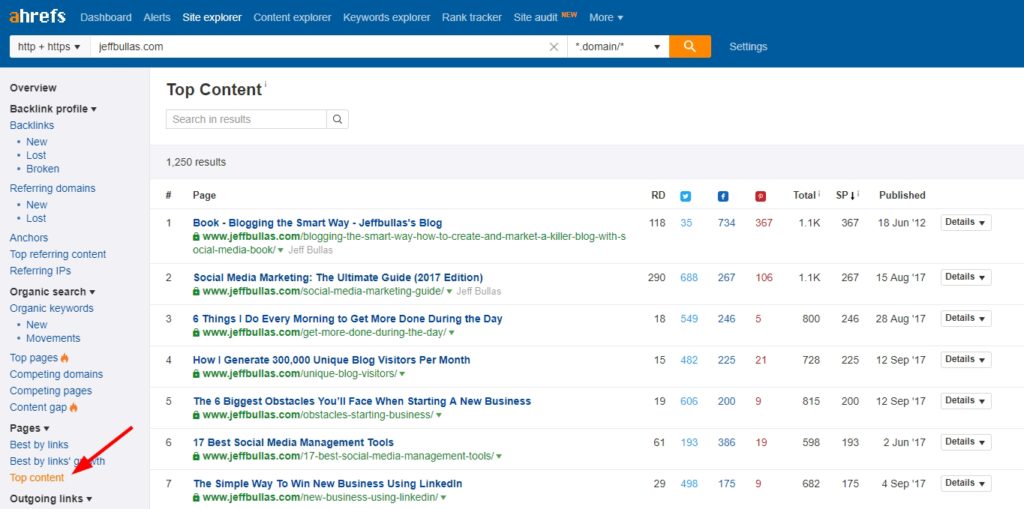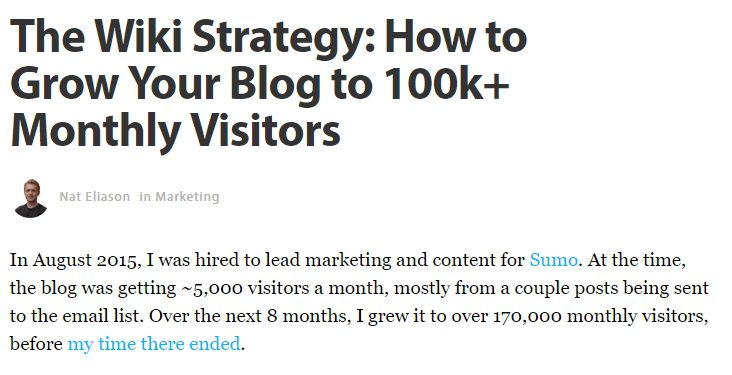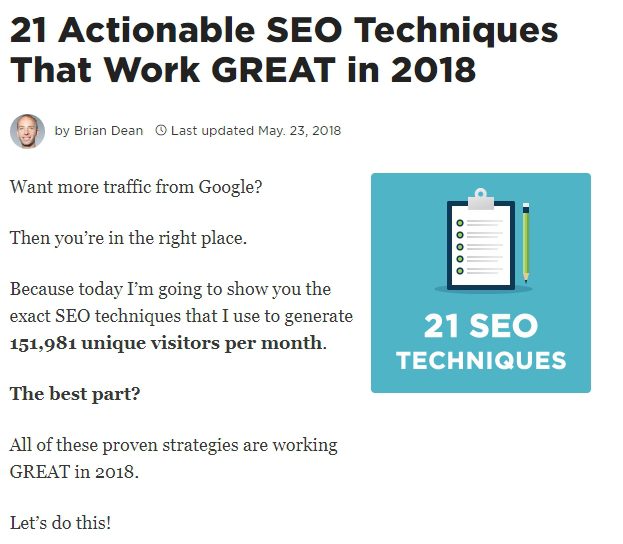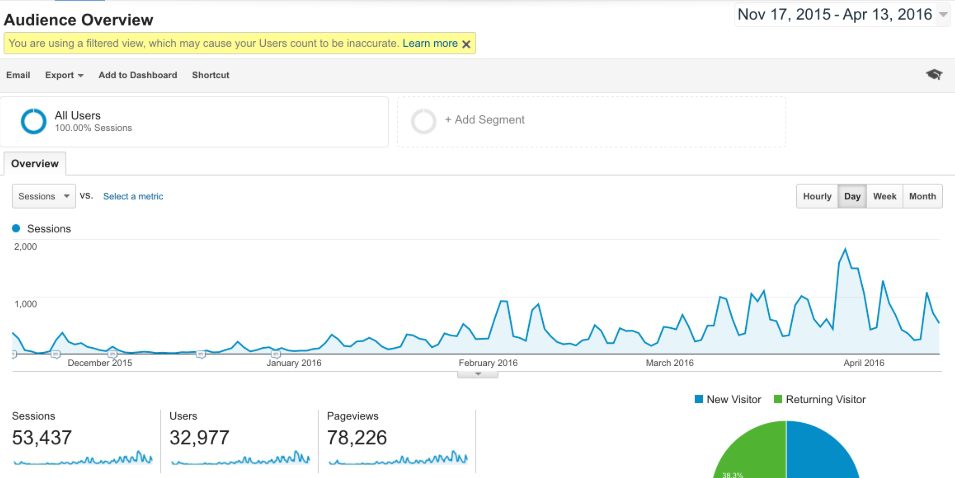
Content marketing can feel like the most frustrating activity in the world.
You spend all your time writing content you think people will like, only to realize nobody is reading it.
It doesn’t have to be that way, though. There’s a proven process that allows you to create highly shareable content over and over again.
In this post, we’ll take you through the steps necessary to create content that gets shared over and over again.
Let’s go.
Step 1: Find a Proven Topic
All highly shareable content originates from one thing: research. If you don’t research, or don’t do it properly, you’ll end up with content that no one cares about and no one wants to read. Research gives you the confidence that what you’re doing is going to work.
During this step, we’re trying to find the answers to 4 questions:
- What topics are my readers interested in?
- Has it been done before?
- How good is the competition?
- Does it have long-term potential?
To figure this out we need to do two things: customer research and competitor research.
Customer research
If you want to find a topic that interests your customers you need to ask what they’re interested in. The tricky part, however, is doing this in a way that doesn’t eat up all your time. There are a couple of ways we can do this.
Source ideas from your customer service team
Your customer service team can help you generate more topics than you’ll ever be able to write about. They have a direct line to your customers and they’re the ones people go to when they have a problem.
If paying customers have those problems, chances are people like them (who might become customers as well) have those problems too.
Do surveys
If you have a sizeable email list, you can send a quick three to five question survey that gives you some insight into the life of your readers. You want to figure out what dreams, fears, and obstacles they have.
Creating content that tackles these three things will help you a lot. If you’re stuck on what questions to ask, here’s a big list of survey questions.
Competitor research
Finding out what your customers and readers want is one thing, but you’ll also need to look at what your competitors are doing. Just as with anything in marketing, if you don’t position it the right way you run the risk of looking like everyone else.
One mistake a lot of businesses make is that they look at competitors to see what kind of content does well and assume it would be a great fit for them, too.
Your content needs to bring in qualified visitors, not just random people. The extra traffic might be good to brag about to your boss, but you’re only fooling yourself.
Here’s an example of content for the sake of content:

Hubspot sells CRM software. An article on how to create animated gif might get a ton of eyeballs, but how many of those people are in the market for a CRM? Not many.
So, how do you check your competition and figure out how to position your content?
Ahrefs
Ahrefs gives you a wealth of information and in most cases, it’s the only tool you need. Just pop in your competitor’s URL and see what pages are doing well from a traffic point of view.
If you click on the “Top Content” section under Pages on the left hand side, it shows you which pages have the most shares and which ones have the most links pointing to them. This gives you an overview of what topics have done well and which pages get linked to the most. More links = more ranking power = more traffic.

Sometimes the simplest solution is the best. Googling your topic can give you an idea of what articles are popular and which ones you need to avoid. Since they’re on the front page already, you can be sure Google likes them. They get a ton of traffic so they’re more likely to get shared.
It also gives you an opportunity to start thinking about how you’re going to differentiate yourself from the competition. If all the articles on the front page are how-to guides, you might want to think about using a different format.
Step 2: Pick a Framework
Now that we’ve got a topic people are looking for, it’s time to brainstorm what we’re going to create.
If you’re going to take content creation seriously, you need to use frameworks. They have a proven track record, give you a structure to work with, and make it easier to create content.
Some frameworks get shared more in certain communities and industries. In the marketing community, for example, tips that are backed by science do really well. There are, however, a couple of frameworks that do well no matter the industry.
The How-To
As the name suggests, you’re going to explain how to do something.
It’s best if you pick one very specific problem and show them how to solve it. The more specific you are, the higher the perceived value. Here’s an example:

If you look at the post, you’ll see Nat didn’t leave out anything. He walks you through the problem and shows you everything you need in order to get the same result.
The Crowdsourced Post
In a crowdsourced post, you reach out to influential people in your industry and ask them one or two simple questions. When you get the answers, you compile all of them into one single post and publish it.
Next, you reach out to the influencers again to let them know you published their advice.
This type of post is great because it gives you social proof (your blog gets associated with influential people) and it gives you a built-in share mechanism. If someone is mentioned in a post they’re more likely to share it with their audience.
Here’s an example from Brian Lang:

The Detailed List
This is an insanely valuable framework, yet most people use it the wrong way.
A list in and of itself won’t get you a ton of social shares. Making your list posts detailed will.
A detailed post uses the same principle as a regular list post: provide X number of tips, but the difference is you take the time to explain those tips in great detail. Instead of just skimming over a high-level concept, you go in and you give specific examples. This increases the value of your content significantly.
Brian Dean from backlinko is amazing at these types of posts. Every time he does one of these he gets thousands of social shares.

The Case Study
Case studies are great because they’re unique and they inspire people. It’s easy to hand out advice, but showing how someone got real results is a lot harder.
The downside to this framework is that it takes quite a bit of resources to create. You have to interview people, transcribe, and turn all that work into a story. The results, however, are amazing. Here are some examples from Patreon:

The Infographic
Infographics can provide your audience with an interesting way to consume content.
The main selling points are its usefulness and its design. If one of the two is lacking, it’s not going to do well.
Step 3: Create The Content
Now that we’ve got our topic and framework, it’s time to do some actual writing. This process is pretty straightforward. You put your butt in a chair and start typing.
But first, let’s look at what makes content worth sharing.
The Ingredients of Highly Shareable Content
Length
It’s been known for a while that longer content (around 1,500 to 2,000 words) tends to get more shares than shorter content. This is because the perceived value is higher with longer content.
The downside, however, is that the moment people figured this out, they started creating long content for the sake of long content.
If you have a topic that doesn’t need a giant article, just keep it short. Long content is useless if people lose interest halfway through.
Specificity
If you look around the web, you’ll find plenty of high-level top 10 lists that don’t help at all.
What makes an article valuable and worth sharing is the specificity. The more specific your topic is, the better. All this boils down to positioning. By being specific, you indicate you know what you’re talking about.
For example: Which of the following headlines are you more likely to click on?
- How I lost weight
- How I lost 15 lbs in 3 weeks while still eating donuts every morning
The second one, right? It’s way more specific and tells us exactly what you’re going to get out of it.
Usefulness
This might seem obvious, but content needs to be useful. Your reader should get something in return for their time.
Useful doesn’t always mean a how-to article, though. Content can be useful if it makes your reader think, laugh, or feel motivated.
Social Currency
People share a lot of stuff on social media because it makes them look good. If you create content with a headline like “Only the best entrepreneurs know this one productivity secret,” you can be sure entrepreneurs are going to share it.
Why? Because if they share it, it implies that they’re one of the few entrepreneurs that know. It shows that they’re part of the ingroup. That’s social currency.
While stroking someone’s over-inflated ego shouldn’t be your primary tool in your content toolbox, it doesn’t hurt to use it once in a while.
Nail the intro
Let’s be real for a moment. The chances that people are going to read your content from start to finish are pretty low. That’s just the nature of the game.
But if you mess up your intro, those chances are even lower.
After the headline, your intro is going to be the most important element of your content. It’s the second thing people see so it should be so good people can’t help but read on.
One way to do this is to use emotions.
If you correctly call out your reader’s emotions, they’re more likely to read on because they feel like you know what they’re going through.
Make content easy to scan
In the same effort to keep people’s attention, make your content easy to scan. This will increase the chances of people reading until the end.
If you’ve ever bought one of those “For Dummies” books, you know what good formatting looks like. Their books use a ton of tricks to make it easier to read.
They make it easier to read by using:
- subheadlines where necessary
- bulleted and/or numbered lists
- images & illustrations
- short paragraphs
Step 4: Promotion
The last step in creating highly shareable content is to promote it. Without promotion, your content isn’t going anywhere.
For a lot of people, this is the hardest step in the process because you have to put yourself out there and potentially face criticism. In reality, you won’t have a lot of problems if you do it right.
Social groups
If you do it right, you can use social groups to grow your entire blog. In fact, that’s exactly what the people over at Growandconvert did.
They wrote articles about marketing and shared them in relevant Facebook groups and communities. As a result, their traffic has increased exponentially.

The key here is to interact with the community your sharing your article with. If you just dump the link in there and leave, you’re not going to get any results.
Influencers
The most straightforward method of promoting your content is to write an email to someone who has an audience and who might be interested in your content.
The key here is to make sure there’s something in it for them. If you write content that isn’t relevant, or it doesn’t help anyone else but you, they’re not going to share it.
It helps if you have an existing relationship you can leverage.
Go Forth and Create Content
Creating good content requires a good deal of research and practice.
If you spend enough time talking to your customers and you spend some time making sure your content is relevant and helpful, you’ll become a content machine in no time.
What’s your favorite way to create content?
Robin Geuens is a freelance content marketer who helps SaaS businesses write content that gets more traffic, subscribers, and leads. You can find him at Atompilot.com.

